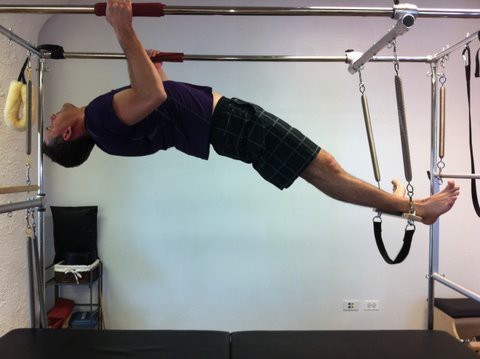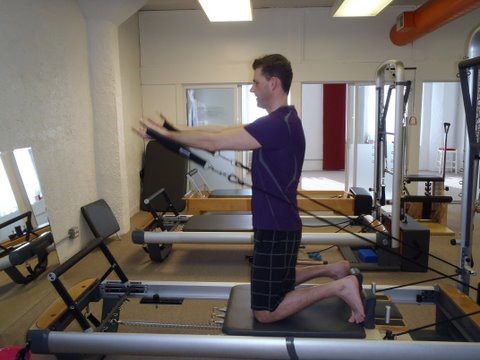APB – All Points Bulletin
WANTED: Pilates Principles for Abs, Posture, and Balance
How does a fitness routine like Pilates train clients for better balance, alignment, and to brace with the core? It’s the basic principles of Pilates that are tied into each exercise until the practice becomes like second nature to us… or even first!
Joseph Pilates didn’t write out a list of principles, but rather he invented exercises and equipment calling his method “Contrology” – the mind-body approach to movement integrating various concepts to attain health. The “Principles” were later defined by his instructors from “Contrology”. What are they? They are Breathing, Centering, Concentration, Control, Precision, and Flow.
Many educational institutions that teach a version of Joseph Pilates’ method have added to or modified the list of Principles. Balanced Body® and BASI Pilates® have 9 and 10 principles including these basic 6, while Stott Pilates® Merrithew Health & Fitness™ has 5 biomechanical principles. For the purpose of this article, we will discuss the six principles generally accepted as the basic principles defined by his instructors.
“Physical fitness is the first requisite of happiness. Our interpretation of physical fitness is the attainment and maintenance of a uniformly developed body with a sound mind fully capable of naturally, easily, and satisfactorily performing our many and varied daily tasks with spontaneous zest and pleasure.”[1]
LET’S TAKE A LOOK AT THE PRINCIPLES
Breathing – When he was a child, Joseph Pilates had rheumatic fever, asthma, rickets, and a weak respiratory system. In his program, he emphasized integrating a full breath into every movement in order to improve the flow of oxygen, focus our awareness, and to increase the capacity of the lungs. The deep inhale breath is into the lower area of the lungs, which expands the ribcage posteriorly and laterally. The exhale breath focuses on co-contracting the pelvic floor muscles and the transversus abdominis.
Squeezing out all the air on the exhale is the key to a full inhale.
Centering – This is physically bringing the focus to the center of the body first, that area between the lower ribs and pubic bone known as the “powerhouse”. Muscles of the power house include the pelvic floor muscles, TA, inner thighs, and multifidus.
Concentration – If one brings full attention to the exercise and does it mindfully with full commitment, maximum value will be obtained from each movement.
Control – Every Pilates exercise is done with complete muscular control. Learning to activate the correct muscles for a particular movement, and keeping the other muscles free of tension, is a constant practice in Pilates.
Precision – Awareness is sustained throughout each movement. There is an appropriate alignment and position relative to other body parts for each exercise, and quality is emphasized over quantity. “A few well-designed movements, properly performed in a balanced sequence, are worth hours of doing sloppy calisthenics or forced contortion.”[1]
Flow – Pilates exercises are done in a flowing manner. Fluidity, grace, and ease are goals applied to all exercises. The effort of each exercise flows through the body evenly, smoothly connecting each exercise to the next.
HOW PILATES PRINCIPLES CAN AFFECT APB – ABS, POSTURE AND BALANCE
The Breathing principle conditions the endurance of the TA and pelvic floor muscles to repeatedly contract throughout the workout. When this becomes an automatic response, it translates into bracing the core prior to lifting or exerting force.
This leads us to the principle of Centering, or recruiting the muscles of the core first. Just being aware of this “powerhouse” as the center of the body helps with balance. When the surrounding muscles of the “powerhouse” are engaged, the lumbo-pelvic region is more protected, making an injury from being off balance less likely.
The Concentration principle is the most important in correcting posture placing the mental focus on awareness of body position and alignment.
The principle of Control allows us to mobilize limbs and joints with a safe range of motion and proper muscular contractions. The control of each separate muscular contraction is important for balance adjustments.
The Precision principle emphasizes correct form and postural alignment. Precision is not only a held position or poses, it is where the energy is coming from and going to. In Mermaid, rather then a pose of bending the spine laterally, there is a lift upward and over.


The principle Flow trains people not only to smoothly transition from exercise to exercise, but also to keep the exercise in a fluid constant motion. Any time there is constant movement, the body is taking pictures of where it is in space, how far away objects are, and how it relates to the world around it. The vestibular system is utilized, which assists in balance training.
Joseph Pilates was convinced that physical health was the cornerstone of overall health and of mind-body-spirit. His method was designed to give us energy – not to fatigue us. He practiced and laid out a program with principles that we now accept as our foundation.
With the staggering amount of overuse injuries, we understand his ideas of precision and concentration – less is more. “It is better to do five repetitions perfectly than 20 without paying attention” [1]
Keeping unnecessary muscles free of tension is economical and natural. One of Pilates’ favorite examples of this is the manner in which a cat moves. Flexibility of the spine potentially provides us a fountain of youth. “The art of contrology proves that the only real guide to your true age lies not in years or how you THINK you feel but as you ACTUALLY are as infallibly indicated by the degree of natural and normal flexibility enjoyed by your spine throughout life.”[1]

Precise and flowing controlled movements are the key to joint safety and stability, the student pictured here is sequentially extending his spinal column.
The ancient practice of breathing with movement, such as in yoga and meditation has long been known for focusing the mind. And in our hectic lifestyle of modern life, it helps us in reducing stress. If you add to that the practice of recruiting the abdominals and expanding the ribs laterally, you have a protected lumbo-pelvic region with an “inner shower”[1] – a fresh exchange of oxygen and carbon dioxide.
PRINCIPLE PROOF
While the ‘Principles’ of Pilates have not been studied in conjunction with improving abdominal strength, posture, and balance, the exercises program has been tested. In a study in Minnesota in 2010, 50 subjects took Pilates twice a week for 12 weeks. They found an increase in abdominal strength, but no improvement in balance or posture. [2] A 2009 study in Montreal, Quebec, Canada tested 19 subjects who took Pilates twice a week for 12 weeks, and subjects improved abdominal strength, and upper spine posture. [3] There is a reason for these outcomes. The majority of Pilates workouts that are tested are of the mat variety. We know that mat work strengthens the core and back extensors. As far as improving balance and posture, the side lying leg sequence in mat work strengthens the gluteus medius, minimus, and the multifidus. To really improve the ability of balance in standing positions, subjects should focus on a more specificity of training in their work out and challenge balance in more vertical positions such as exercising with the springs and pulleys on the Pilates’ equipment. In the Peyow™ Aqua Pilates program, many of the traditional mat exercises have been modified to vertical or plank positions, including resistant exercises from the reformer, Cadillac, barrels, and small equipment.

“Moreover, such a body freed from nervous tension and over-fatigue is the ideal shelter provided by nature for housing a well-balanced mind that is always fully capable of successfully meeting all of the complex problems of modern living”. [1]
We are beings in motion, and movement should be easy with the correct control, balance, and proper posture. Integrating Joseph Pilates’ key principals into daily life will allow us to flow through life as the efficient, graceful, healthy beings we were meant to be. He knew he was ahead of his time, but dreamed that everyone one day would benefit from his “Return to Life Through Contrology” ideals. Who wouldn’t like to have stronger Abs, perfect Posture, and better Balance?
Resources:
[1] Pilates’ Return to Life Through Contrology, by Joseph H. Pilates and William John Miller, c.p.1998 Presentation Dynamics Inc.
[2] J Strength Cond Res 2010 Mar; 24(3):661-7. Dept. of Health and Exercise Science, Gustavus Adolphus College, St. Peter MN USA “Pilates for Improvement of Muscle Endurance, Flexibility, Balance, and Posture.”
[3] Clin Biomech (Bristol, Avon) 2010 Feb; 25920:124-30. Epub 2009 Oct 30. Dept. of Kinesiology and Physical Education, McGill University, 475 Pine Avenue West, Montreal, Quebec, Canada. “The Effects of a Pilates Training Program on Arm-Trunk Posture and Movement.”
Photos: Anne Pringle Burnell, Peninsula Spa Chicago, Todd Getz, Private Pilates at Core Evolution.
Anne Pringle Burnell is the creator of the Stronger Seniors® Workout Program and Peyow™ Aqua Pilates, certified by AEA, ACE, AFAA, Nia Technique Black Belt, and Stott Pilates™ and an Education provider for AEA, ACE, AFAA, and Stott Pilates™. Anne teaches at The Rehabilitation Institute of Chicago, Northwestern Memorial Hospital, Peninsula Spa Chicago, University of Illinois Chicago, Elements in Motion, and Private Pilates at Core Evolution. She has been a presenter for The American Cancer Society, The American Lung Association, Susan B. Komen Breast Cancer Foundation, National Council on Aging/American Society on Aging, Northwestern Hospital Integrative Medicine, and OSHA Center at Northwestern University.

